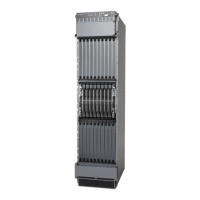MX2020 Component Redundancy
A fully-configured router is designed so that no single point of failure can cause the entire system to fail.
Only a fully-configured router provides complete redundancy. All other configurations provide partial
redundancy. The following major hardware components are redundant:
•
Host subsystem—The host subsystem consists of a Routing Engine functioning together with a Control
Board. The MX router can have one or two host subsystems. Each host subsystem functions as a unit—the
Control Board and Routing Engine (CB-RE). To operate, each host subsystem requires one or two Routing
Engines installed into the front of the chassis in vertical slots labeled 0 and 1. If two CB-REs are installed,
one functions as the master and the other functions as the backup. If the master host subsystem (or
either of its components) fails, the backup can take over as the master. See “MX2000 Host Subsystem
CB-RE Description” on page 49.
If the Routing Engines are configured for nonstop active routing, the backup Routing Engine automatically
synchronizes its configuration and state with the master Routing Engine. Any update to the master
Routing Engine state is replicated on the backup Routing Engine. If the backup Routing Engine assumes
mastership, packet forwarding continues through the packet transport router without interruption.
•
Power system—The MX2020 router has up to four power distribution modules (PDMs) that share the
load evenly. If one PDM fails in a fully redundant power system that includes two PDMs and nine power
supply modules (PSMs), the other PDM can provide full power to the MX router indefinitely. PSM
redundancy varies depending on the number of PSMs and number of Field Replaceable Units (FRUs).
See the “MX2020 Power Subsystem Description” on page 91 for more information about power system
redundancy.
•
PSMs—All AC or DC PSMs in the power subsystem share the load (the nine PSMs in the upper card cage
share the load, and the nine PSMs in the lower card cage share the load). If one PSM fails in a redundant
configuration, the remaining PSMs provide power to FRUs. In the AC or DC configuration, up to eighteen
PSMs may be required to supply power to a fully configured router.
In a fully configured MX2020 router with 18 PSMs, the nine PSMs in the upper card cage and the nine
PSMs in the lower card cage supply power to:
•
10 line-card slots
•
Four Power Distribution Modules (PDMs)
•
20 Modular Port Concentrators (MPCs) (10 MPCs per zone)
•
Two fan trays
•
Eight Switch Fabric Boards (SFBs)
•
Two Control Board and Routing Engines (CB-REs)
A portion of power from each zone is reserved to power critical FRUs. These FRUs allow the system to
operate even if power to a complete zone fails.
13

